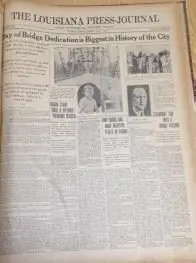
Louisiana bridge once seen as national connector
The original Champ Clark Bridge was envisioned as a link between America’s coasts.
At the time, air travel was a novelty and the first interstate highways were still almost 30 years from construction.
So, stakeholders in the 1920s proposed giving heightened national status to two-lane roads such as U.S. Highway 54 through Louisiana. It was dubbed the “See America Route.”
“The Champ Clark Bridge may be regarded as a good-will messenger, for its influence in bringing the people close together will be great,” predicted the Louisiana Press-Journal.
“While the building of the Champ Clark Bridge was a local project, it has become a major factor in the cross-continent highway and will be a wonderful convenience for tourists and motorists, and has become of national prominence,” the St. Louis Post-Dispatch told readers.
George E. Drummond of the Automobile Club of Missouri predicted the bridge would “play an important part in increasing the number of tourists between the East and the West through this section of the country.”
The Mexico Ledger reported that with completion of the bridge, U.S. 54 would “become the center of much cross-country travel” and offer a “taste of tourist traffic it has never experienced in the past.”
The crossing will “inaugurate the scenic route straightway through the middle of the USA, a new highway of travel across the continent and a shorter route between Kansas City and Chicago,” noted the Kansas City Journal, which offered free maps of the route.
At a time when many roads still were gravel, it didn’t hurt that much of Highway 54 – spanning almost 1,200 miles from Griggsville, Ill., to El Paso,Texas – was paved.
Further proof of the route’s importance came during the bridge dedication on Saturday, June 9. Almost all of the 48 states were represented among the 30,000 people who crowded into town. Skies were sunny and the temperature was 72 degrees.
Kansas City Mayor Albert Beach and Chicago Mayor William Thompson joined Missouri Gov. Sam Baker and Illinois Gov. Len Small in placing ceremonial golden rivets. Louisiana Mayor J.W. Crewdson welcomed the crowd.
Champ Clark had died in 1921, but his widow and other family members were present. A parade overseen by Edwin Stark stretched for a mile. Bands from area communities participated.
The day also featured an air show and a boat regatta. The Press-Journal noted a bit of nostalgia when it observed that “the old ferry boat, reading its doom in the mighty steel structure above it, plied back and forth as if in search of passengers as it had done for the last fifty years.”
Nursery executive Lloyd Stark, who within a few years would serve as Missouri governor, had served as the biggest proponent for construction. Baker praised him as the man who “saved Missouri’s road program” and Small called him someone “who will go down in history as having built more miles of concrete roads than any man who lived on the face of the earth.”
Clark’s daughter, Genevieve, unveiled a memorial tablet. His son, Bennett Champ Clark, who was then in consideration for a U.S. Senate seat, declined a chance to speak. However, his four-year-old son, Champ, cut the dedication ribbon and sat on Small’s lap.
Parking places were at a premium, waitresses at local restaurants reported being on their feet for hours and telegraph wires were kept busy by reporters sending out stories.
“Even the most skeptical have nothing to the contrary to say,” the Press-Journal noted. “It was a grander success than even the most optimistic, bubbling over with enthusiasm for the big celebration, had the temerity to hope for.”
Tolls to help fund the $1 million construction cost were collected until 1952. The structure was replaced by the $60 million Champ Clark Bridge on Aug. 3, 2019.
- Bennett “Ben” Clark, Champ’s great-grandson, spoke at the groundbreaking for the new bridge in 2017 and at the opening ceremony in 2019.
Words written by the Press-Journal in 1928 could have been uttered at the groundbreaking, and certainly seem appropriate almost a century later.
“It is not a one-city affair,” the newspaper said. “It was an occasion in which many cities and many counties of a considerable section of the great Mississippi valley were interested. The Champ Clark Bridge may be regarded as a good-will messenger, for its influence in bringing the people close together will be great.”
CUTLINES FOR PHOTOS:
A headline in the June 12, 1928, edition of The Louisiana Press-Journal proclaims “Day of Bridge Dedication is Biggest in History of the City.”
The former Champ Clark Bridge as it appeared on Aug. 28, 2013.
